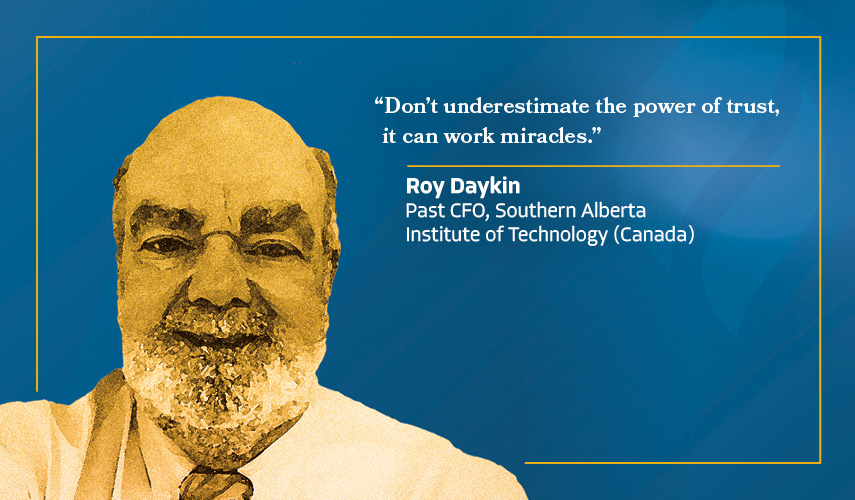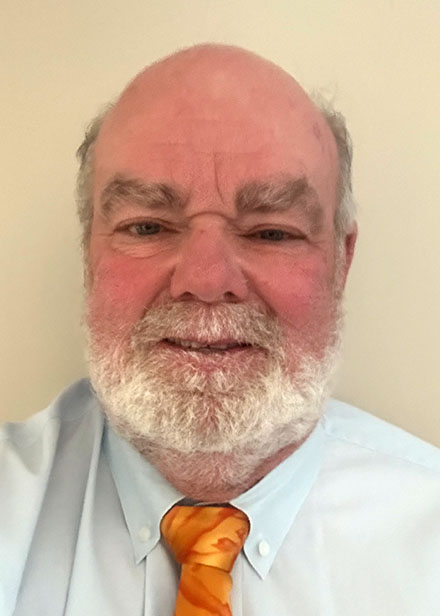
Courageous Leadership
Trust, Tough Decisions, and Finding a Way Forward
Looking back on my time as CFO at Southern Alberta Institute of Technology (SAIT) in Calgary, Alberta, I’ve come to realize that leadership isn’t just about managing budgets or balancing spreadsheets—it’s about trust and having the courage to make tough decisions, even when the outcome is uncertain. From the moment I stepped into the role, I knew I needed to trust my team, and they needed to trust me. Trust speeds everything up, enabling decisions to be made quickly, even in the face of uncertainty. It’s something I leaned into naturally throughout my career, and while it occasionally led to challenges, it always paid off in the long run. More than anything, trust was what helped us navigate the tough times.
Don’t underestimate the power of trust, it can work miracles.

By Roy Daykin
Former CFO
Southern Alberta Institute of Technology
Weathering the Storm
One of the hardest decisions we faced was in 2019 when our provincial funding was cut by $10 million halfway through the fiscal year. We knew another $10 million funding reduction was planned for 2020 with an additional $20 million in the following two years. We also expected inflation to increase costs by $10 million over the time of the cuts. I remember sitting down with Dr. David Ross, our president, and saying, “Let’s do it all at once. Let’s figure out how to absorb the total reduction right now and get it over with. We need to focus primarily on how to increase revenues as well as reduce costs.” I knew we had to have a plan, or employees and students would live in constant fear about what might come next. I knew that if we did not get out into the SAIT community to talk about the plan and be positive about the future that people would make up their own stories, which were often much worse than what was planned. It wasn’t an easy thing to propose, knowing that it would mean laying off people and cutting programs that had been around for years. But I also knew that dragging it out with uncertainty over four years would be more painful in the long run.
So, the plan was to make a one-time reduction of $20 million to deal with the immediate cuts and increase revenues by $25 million over three years to offset the future government reductions and inflation. We did it. About two thirds of the reduction came from reducing personnel. It hurt; there’s no getting around that. But it was the right decision. By taking that step, we were able to stabilize quickly and demonstrate to our employees that we had a plan. The following year, we were back with a surplus and didn’t have to worry about more cuts hanging over our heads. We made the hard decision once, and then we were able to move forward and rebuild.
I believe being very public and transparent with the plan was critical to its success. We answered the tough questions about its impacts and provided a positive outlook for the future. We demonstrated to the SAIT community that the executive leadership had confidence that the Institute would be successful and continue to grow even though government funding was cut. The employees saw our plan — which was very different than other institutions’ approach, which mostly focused on reductions — and I believe it inspired them to be positive about SAIT’s future.
The irony is, even though we were making cuts, we never stopped growing. In 2020 and beyond, we expanded both international and domestic enrolments. We brought in thousands more students from abroad and increased the number local students. We expanded programs that were in demand, and we increased service levels to support student growth. This wasn’t just about growth for the sake of it. We did it because we knew international students would provide the funding needed to support and grow our domestic enrollments. The reality is, international students pay more than domestic students, as required by government regulation. The extra revenue allowed us to maintain the quality of education for all our students, even during the pandemic.
I believe, if we had not made those decisions—if we hadn’t expanded our international and domestic enrolments or made the budget cuts—SAIT, its employees, and our students would have had a very difficult time during the pandemic. It was tough, but it worked. By the time the COVID-19 pandemic hit, we were ready. We had already made the cuts, and we had the financial flexibility to figure out how to get students back into labs safely, which was critical for a place like SAIT, where so many of our programs are hands-on.
The Power of Trust
I’ve been lucky to work with leaders like David Ross, who trusted me enough to make these bold decisions. We’ve known each other since the late ‘90s, and this was the third institution we worked at together. That kind of relationship, where there is mutual respect and trust, made all the difference. He saw the obstacles, and my job was to help us navigate through them.
I think the most important lesson I’ve learned is that leadership isn’t about having all the answers; it’s about having the courage to make tough calls and trusting that your team can help figure out the rest. One of the books that really shaped my thinking on this is The Speed of Trust by Stephen M. R. Covey. It talks about how organizations that have high levels of trust actually make more money because they’re more efficient, and they get things done faster. That resonated with me. I saw it firsthand at SAIT. We were able to move quickly and make decisions that kept us ahead of the curve because we trusted each other.
Advice for Today’s Leaders
As I think about the future of higher education, I know there are going to be even bigger challenges ahead. The financial pressures aren’t going away, and the competition for students will only get tougher. Institutions that don’t find ways to innovate and bring in more revenue are going to struggle. I believe artificial intelligence is going to play a huge role in that—both in terms of making our institutions more efficient and in helping attract students who expect cutting-edge technology in their education. It’s going to take courage to embrace that change, but I’m confident those that do will come out ahead.
If there’s one thing I’d say to leaders in higher education today, it’s this: Don’t underestimate the power of trust, it can work miracles. And don’t be afraid to make tough calls It’s what kept us going at SAIT, and I believe it’s what will help our institutions navigate the uncertain times ahead.

